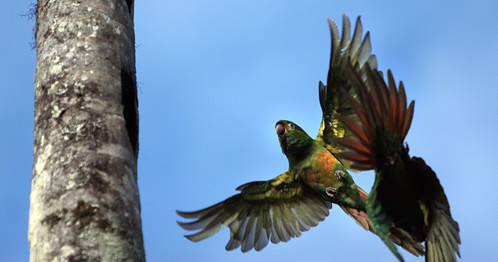 Golden-plumed parakeets in a palm tree.
Golden-plumed parakeets in a palm tree.
The Golden-plumed Parakeet (Leptosittaca branickii is classified as Vulnerable in the IUCN Red List of Threatened Species and numbers are thought to be as low as 400 birds. They only occur in fragmented habitats in montane forest on the east slope of the Andes from northern Colombia and Ecuador to Peru in temperate cloud and elfin forest at 2,400-3,400 m, occasionally lower. They depend on Wax palms (Ceroxylon sp) in which they take refuge and make their nests, and are heavily dependent on Podocarpus cones for food.
Golden-plumed parakeets are present in Podocarpus National Park and these birds were photographed on the border of the Christopher Parsons sector of the Jocotoco Foundation's Tapichalaca Reserve and the Podocarpus National Park, nesting in a dead Wax palm. Both Wax Palms and Podocarpus trees are being lost through deforestation and this does not bode well for the future of these parakeets, outside protected areas. On Palm Sunday this year there was a high profile campaign in Quito, supported by the church, to encourage people to wave corn stalks and branches from ornamental plants instead of traditional palm fronds and the woven crosses made from Wax palm, in an attempt to alert people to the plight of the Golden-plumed Parakeet.
Another bird, the Yellow-eared parrot, also depended on the Wax palm for its survival but there have been no confirmed sightings in Ecuador for eight years.
The Christopher Parsons rainforest was purchased from funds raised by World Land Trust in memory of Christopher Parsons, a WLT Trustee, who died in 2002. He was the producer of Life on Earth and a close friend of Sir David Attenborough.